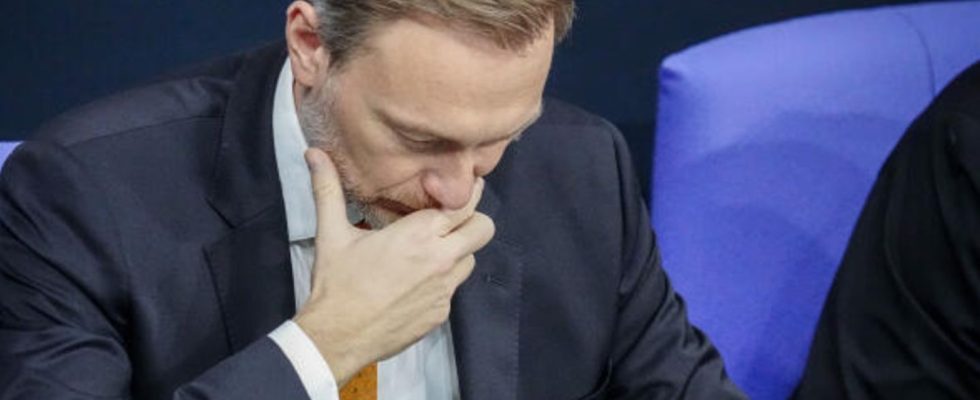The members of the FDP voted by a narrow majority to remain in the traffic light coalition. What does this mean for the government? And for Christian Lindner? The most important questions and answers.
The question to the party base was simple and direct: “Should the FDP end the coalition with the SPD and the Greens as part of the federal government?” You could answer with “yes” or “no”. The FDP had been surveying its members since December 18th after an application for this procedure reached the necessary number of votes of 500.
The result came with the new year. Accordingly, a narrow majority wants to remain in the traffic light coalition. 52.24 percent of voters are in favor of continuing to govern with the SPD and the Greens. 47.76 percent want to leave the coalition. 26,058 of the approximately 72,100 party members took part, i.e. just over a third.
This much is clear: Things could have been worse for Christian Lindner and the FDP leadership. But what does that mean for the party and the government – here are the most important questions and answers.
What exactly follows from the member survey?
It was clear before the survey that the result, whatever it was, would not be binding. Unlike a member decision, a member survey is only there to get an idea of the mood from the grassroots. This is what the FDP statutes provide. The party leadership had previously sold the fact that only 500 members were needed to initiate such a process as a positive feature of a “participatory party”.
What you can read from the result is therefore a question of interpretation. Of course, you can see it as a success that more than a third of the members voted during the Christmas season and are celebrating themselves as a “digital participatory party”. Or you can ask yourself whether the rest have refrained from doing so out of disinterest, dislike or approval of the traffic lights.
Research into the causes can also follow different approaches. Why is approval for traffic lights so close? Is it because the Liberals aren’t doing enough in government? Could it have something to do with the fact that the Liberal party leadership itself so often speaks badly about “this left-wing government” that it wants to be the corrective to? Or are many FDP members simply constantly in a bad mood when they see Vice Chancellor Robert Habeck on television and remember that they govern together with him?
But one thing can be said without a doubt: For everyone who didn’t want to believe it, the FDP has now documented once and for all how unpopular and even hated the traffic light is in a part of the party that is so big that it cannot simply be ignored can.
How did the party leadership react?
FDP General Secretary Bijan Djir-Sarai was satisfied. He sees the result as “strengthening the support of the FDP leadership”. The vast majority of voting members want the FDP to continue to assume responsibility.
Party vice-president Wolfgang Kubicki was also pleased with the result. “The party wants the FDP to continue to participate in the government with a clear majority,” he told the “Süddeutsche Zeitung”. The “silent majority” apparently did not want to leave the government. “With this tailwind, we are now doing better in the coalition.” Kubicki, who himself rarely skimped on traffic light criticism, now hopes: “The nonsense has to stop.” Ultimately, they want to achieve a double-digit election result again in the next federal election in 2025.
Is calm now returning to the FDP?
The party leadership will have plenty of opportunity in January to aggressively demonstrate unity and confidence. First, the Liberals traditionally meet on Epiphany in Stuttgart, where Lindner and Djir-Sarai will give a speech. Then there will be the European Party conference in Berlin at the end of the month. The party will nominate Marie-Agnes Strack-Zimmermann as its top candidate for the European elections. The Grande Dame of the FDP will probably know how to use her rhetorical talent to spark new motivation among the Liberals after weeks of self-deliberation.
The rank-and-file rebels who initiated the survey in the first place will be able to cope with the narrow result. Maybe take it as proof of how good her instincts were. At the federal party conference at the end of April at the latest, they will be looking for a new opportunity to campaign for a withdrawal from the traffic lights on a large stage. After all, it cannot be ruled out that the federal government will still be in a deep crisis and the FDP will fall below five percent again in surveys.
For all the traffic light critics in the FDP parliamentary group, who, for example, raised a lot of sentiment against “Habeck’s heating hammer”, the member survey couldn’t have gone better. They don’t have to fear new elections and can continue to participate in government – and always refer to how unpopular the traffic light is among their own people. What was previously just a gut feeling argument for opposition in the coalition is now well documented.
So what does that mean for the traffic lights?
Yes, the SPD and the Greens can take a deep breath for now. Very briefly, perhaps. With this result, they are spared a major debate about the FDP’s exit from the traffic light. The Chancellor will see it as one less problem. Otherwise, little will change. “The members want a clear liberal handwriting in the government,” said FDP General Djir-Sarai as the slogan. But that was already the slogan before the member survey.
You can list many examples that prove that the FDP has pushed through its own projects in relation to its 11.5 percent in the last federal election. The liberal handwriting is recognizable. Apparently the further you move away from the FDP base, the more clearly it becomes clearer. Which ultimately leads back to the question: What role does the party leadership itself play in its communication in making the traffic light so unpopular within its own ranks? The resting pulse of the traffic light depends on how the FDP leadership assesses this chicken-and-egg problem – and what lessons they learn from it.
And what about Christian Lindner?
According to the classic laws of power politics, a member’s rejection of the traffic light would also have been a vote of no confidence in the party leader. Lindner has always emphasized that the FDP entered this government out of a sense of political responsibility. His reaction to the questioning was corresponding. He assessed the result as a “clear mandate to continue to show a liberal profile in government actions.” The Federal Finance Minister wrote on X (formerly Twitter) that he saw the outcome of the vote “as an expression of responsibility for Germany.”
Who would have taken responsibility for the FDP, the result would have been only slightly different – that is another debate that the Liberals are fortunately spared. No matter how great the dissatisfaction with the traffic lights may be among some members, there is so far no sign that this has a negative impact on satisfaction with Lindner as party leader and minister.
On the one hand, that is the good New Year’s message for the party leadership.
On the other hand, who else should do the job?



